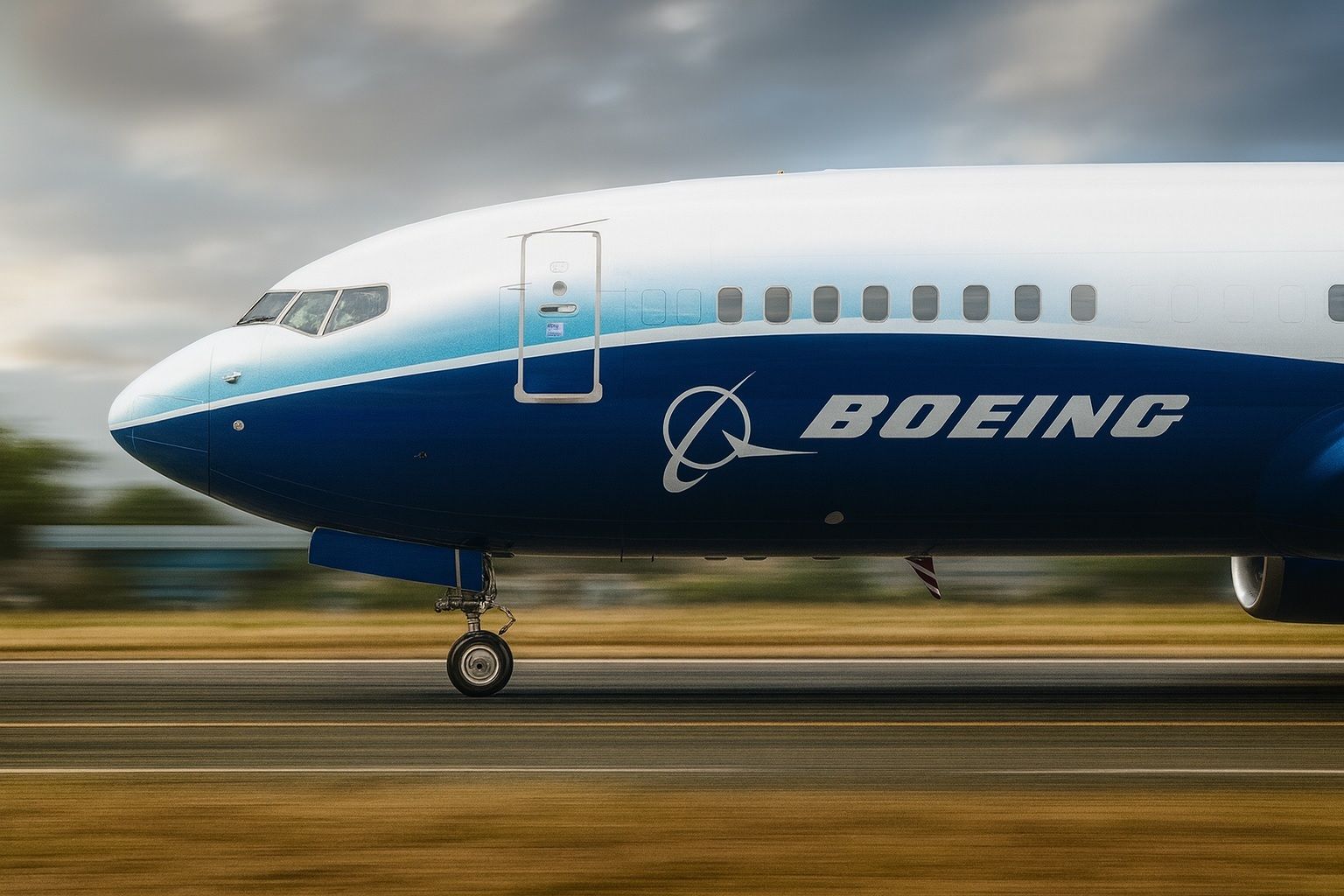Boeing (NYSE: BA) is trading in a tight range today as investors digest a powerful mix of good and bad headlines: the end of a 101‑day defense strike, rumoured orders for up to 300 jets at next week’s Dubai Airshow, fresh defense and space contract wins – and a high‑profile NATO surveillance setback plus renewed concerns about cash flow.
As of mid‑afternoon trading in New York on Friday, November 14, Boeing shares were hovering around $194–195, roughly flat on the day after swinging between about $192 and $197. That keeps BA well off its 52‑week high near $243, but comfortably above the year’s low around $129. [1]
Over the last year, the stock is still up by roughly the high‑30% range, but it has slipped more than 12% since late October’s earnings report, when Boeing announced a new multi‑billion‑dollar charge on its delayed 777X program and pushed back its service entry, spooking investors who had been hoping for a cleaner cash‑flow story. [2]
Below is a detailed look at all the key Boeing stock news driving BA today, 14 November 2025, and what it could mean for traders and longer‑term investors.
BA share price today: calm surface, stormy undercurrents
- Price level: Around $194–195 per share in Friday afternoon trading.
- Intraday range: Roughly $192.1 to $197.0 so far today, showing modest volatility as new headlines hit the tape. [3]
- Market cap: About $147 billion, with average daily volume a little above 8 million shares. [4]
Despite the flurry of positive operational news — from a resolved labor dispute to fresh contract wins and a major satellite launch — BA is only moving fractionally. The muted reaction reflects a market still focused on:
- The hangover from the late‑October 777X charge and delay, which pushed the stock down double digits in two weeks. [5]
- Ongoing concerns about capital intensity and free cash flow, highlighted again this morning by Bernstein SocGen’s lowered price target. [6]
101‑day St. Louis strike ends: operational overhang finally clears
One of the biggest overhangs on Boeing’s defense business is now officially gone.
After a 101‑day walkout, about 3,200 Boeing Defense machinists in the St. Louis area – members of IAM District 837 – have ratified a new five‑year contract, ending the company’s longest‑ever strike at those facilities. [7]
Key points from the new deal:
- Contract length: 5 years, covering workers in Missouri and Illinois who assemble F‑15 and F/A‑18 fighters, the T‑7 trainer, munitions and 777X wing sections. [8]
- Compensation: Around 24% wage increases over the life of the contract, plus a $6,000 signing bonus per worker, after previous offers with lower upfront cash were rejected. [9]
- Return to work: Employees are scheduled to return to the lines starting Sunday, November 16, allowing Boeing to ramp back toward normal defense production. [10]
Market reaction has been nuanced:
- On the positive side, the end of the strike removes material near‑term operational risk, freeing up fighter‑jet and weapons production and smoothing the defense supply chain. [11]
- On the negative side, the contract locks in higher labor costs, adding longer‑term margin pressure to a division already under scrutiny for program overruns.
TipRanks notes that despite the resolution, BA slipped fractionally in Thursday’s session as investors weighed improved visibility against higher structural costs. [12]
Dubai Airshow 2025: Flydubai’s 300‑jet order rumor boosts sentiment
With the Dubai Airshow (Nov 17–21) just days away, Boeing is suddenly at the center of one of the show’s biggest storylines.
Boeing reportedly leads for 300‑jet Flydubai deal
Bloomberg and Reuters report that Boeing currently leads the race for a roughly 300‑aircraft order from Dubai’s low‑cost carrier Flydubai, centered on single‑aisle jets, though Airbus is still in contention for a slice of the deal. [13]
While exact model splits and pricing have not been disclosed, the potential order:
- Would be one of the largest narrow‑body commitments in the region’s history.
- Could anchor Boeing’s presence at the show, alongside its ongoing effort to defend market share against Airbus and the rising Chinese COMAC C919. [14]
Analysts expect around 300 total aircraft orders to be announced at the airshow across all manufacturers, with Boeing vying to maintain its commercial momentum after a tough few years. [15]
777X in the spotlight – even after a painful charge
Boeing is also flying its 777X to Dubai for a high‑profile demonstration, positioning the long‑delayed wide‑body as a flagship for Gulf carriers. [16]
But this marketing push comes on the heels of:
- A $4.9 billion pre‑tax charge recorded in late October tied to the program. [17]
- Yet another delay to the 777X’s entry into service, a key reason BA has given back more than 12% since earnings. [18]
In other words, Dubai is both an opportunity and a test: big new orders could reassure investors that Boeing’s wide‑body strategy still has legs, but the 777X remains a symbol of execution risk and capital drain.
Dreamliner ramp‑up: South Carolina expansion aims to double 787 output
Separately, Boeing is trying to turn its popular 787 Dreamliner into a more powerful cash generator.
Aviation International News reports that Boeing broke ground in Charleston, South Carolina, on an expansion that could ultimately double Dreamliner production capacity at the site, supporting a target of around 10 aircraft per month by 2026. [19]
Bernstein SocGen highlighted this expansion in its note today, arguing that:
- The 787 backlog of about 1,000+ aircraft justifies heavy investment in additional capacity.
- Higher 787 output is critical for mid‑to‑late‑decade free‑cash‑flow improvement, even if it temporarily weighs on near‑term cash. [20]
For BA holders, the Dreamliner story is increasingly binary: if Boeing executes on production ramps and avoids major new quality issues, 787 deliveries can be a core cash‑flow engine. If not, the company risks another round of disappointment in a market that’s already wary.
Space win: ViaSat‑3 F2 satellite launches successfully
On the space side of the portfolio, today brought a clear positive.
Boeing confirmed that ViaSat‑3 F2, the second in a trio of ultra‑high‑capacity broadband satellites it is building for Viasat, successfully launched on a United Launch Alliance Atlas V last night and is “healthy on orbit”. [21]
Highlights:
- Built on Boeing’s 702MP+ platform with all‑electric propulsion and high‑power solar arrays.
- Expected to more than double Viasat’s bandwidth capacity, delivering over 1 terabit per second of total network capacity for commercial mobility (like in‑flight connectivity) and defense users. [22]
While not a massive share‑price mover by itself, the successful launch:
- Shows Boeing Space executing on complex, high‑value projects.
- Reinforces the company’s role in satellite‑based connectivity, which dovetails with its airline customer base.
Defense: big Chinook win vs. NATO Wedgetail setback
News out of the defense side is mixed – one major contract win and one painful public rebuff.
$876 million US Army deal for up to 60 Chinooks
The Defense Post reports that Boeing has secured an $876.4 million contract to supply up to 60 CH‑47F Chinook heavy‑lift helicopters to the US Army. [23]
Key details:
- Includes performance‑based logistics, training and non‑recurring engineering, with work to be carried out at Ridley Park, Pennsylvania.
- Deliveries are planned through October 2035, and the order covers the modernized Block II configuration, which offers improved range, payload and survivability. [24]
This deal extends Chinook’s production runway well into the next decade and underlines how important legacy platforms remain for Boeing’s defense cash flow.
NATO walks away from Boeing Wedgetail plan
On the downside, another Defense Post piece today notes that a consortium of six NATO countries has abandoned plans to buy Boeing E‑7 Wedgetail aircraft to replace the alliance’s AWACS fleet, after the United States pulled out of the program earlier this year. [25]
- The move opens the door for European‑built surveillance aircraft, as allies look to support local industry and reduce reliance on US platforms.
- For Boeing, it represents a lost strategic opportunity in high‑end airborne surveillance, a niche where it has long enjoyed strong positioning.
Taken together, the Chinook and NATO stories show a split narrative: Boeing remains deeply embedded in US rotary‑wing procurement, but faces growing competition for large multinational fixed‑wing defense programs, especially in Europe.
Analyst view: targets trimmed, but rating still bullish
Wall Street weighed in again this morning – and the message is “still like it, but with more caution.”
Bernstein SocGen cuts target to $267
Investing.com reports that Bernstein SocGen lowered its Boeing price target to $267 from $287, while keeping an “Outperform” rating. [26]
The firm cited:
- The stock’s sharp slide since the Oct. 30 earnings report, despite revenue beating expectations.
- Investor worries about capex and free‑cash‑flow trajectory, especially around 777X and 787 investments.
- Continued confidence that ramp‑ups in 737 and 787 production (42 and 8 per month, respectively) and a strong backlog will support long‑term upside, provided execution improves. [27]
Susquehanna, meanwhile, recently cut its own target from $270 to $255, also maintaining a positive stance but acknowledging higher risk. [28]
TipRanks aggregates recent opinions into a “Strong Buy” consensus for BA, with an average target around $258 – implying roughly 30% upside from current levels – based on 13 Buys and 2 Holds over the last three months. [29]
Credit outlook: S&P more relaxed on solvency risk
On the credit side, S&P Global Ratings recently revised Boeing’s outlook to “stable” from “negative”, reflecting expectations that cash generation will improve as key programs mature, even after the 777X charge. [30]
That doesn’t remove execution risk, but it reduces near‑term downgrade pressure, an important consideration for such a highly levered company.
Institutional flows and quant signals: mixed messages
Today’s filings and model‑driven research paint a picture of divided but engaged investors.
Institutional investors: some trimming, some adding
MarketBeat highlights a flurry of 13F updates involving BA:
- Allianz SE opened a new position of 4,844 Boeing shares, valued around $1.0 million, during the second quarter. [31]
- Prospect Financial Services LLC trimmed its stake by 8.4%, selling 3,885 shares but still holding 42,449 sharesworth about $8.9 million. Boeing remains its third‑largest holding at roughly 5.3% of its portfolio. [32]
- WASHINGTON TRUST Co slashed its position by 56.1%, selling 2,559 shares and ending the quarter with 2,002 shares worth about $419,000. [33]
Fintel data suggests Boeing has over 3,200 institutional owners, with hundreds of millions of shares collectively held, underlining that BA remains a core large‑cap aerospace holding despite recent volatility. [34]
In short: there is no sign of a wholesale institutional exodus, but we are clearly seeing positioning tweaks as funds rebalance risk after the 777X surprise and recent share‑price swings.
Quant/technical view: “choppy” with elevated downside risk
A fresh report from StockTradersDaily uses AI‑driven “liquidity mapping” to analyze BA and concludes that: [35]
- Sentiment across time‑frames is divergent, implying choppy trading conditions.
- There is no clear directional signal, with both long and short tactical setups highlighted around the current price.
- The model flags “elevated downside risk” in the absence of strong long‑term support signals, even though longer‑term resistance levels sit much higher than today’s price.
For short‑term traders, that translates into a high‑noise, range‑bound environment, where news flow and macro swings can rapidly dominate the tape.
How today’s headlines reshape the Boeing (BA) story
Putting it all together, here’s what 14 November 2025 adds to the Boeing investment narrative:
Clear positives for the stock
- Operational bottleneck removed
The St. Louis defense strike is over. That reduces near‑term delivery and revenue risk for key fighter and munitions programs and should help stabilize the Defense, Space & Security segment. [36] - New orders and contract visibility
- Proof points in space and wide‑body execution
A successful ViaSat‑3 F2 launch and ongoing 787 expansion plans show that not all big programs are stumbling; some are hitting milestones and building future cash flows. [39]
Lingering and emerging risks
- Cost inflation from labor settlements
The St. Louis contract ends disruption but bakes higher wages and bonuses into Boeing’s cost base, pressuring long‑term margins unless pricing or productivity improve enough to offset them. [40] - Program and cash‑flow uncertainty
The 777X charge and delay remain a central concern. Combined with heavy 787 capex, this is why analysts are trimming – not raising – price targets today, even as they keep positive ratings. [41] - Competitive pressure in defense and surveillance
NATO’s decision to ditch the Wedgetail plan undercuts Boeing’s ambitions in high‑end surveillance and signals a stronger European tilt in future procurement. [42] - Ongoing legal and reputational overhang
Recent headlines about Boeing being ordered to pay over $28 million to a 737 MAX crash victim’s family and families pushing to revive a criminal case underline that legacy MAX issues still carry financial and reputational risk, even if they’re not front‑page today. [43]
What 14 November 2025 means for BA investors
For short‑term traders, today’s setup looks like this:
- News flow is headline‑dense but directionally mixed – bullish (strike resolution, contracts, satellite launch, Dubai buzz) vs bearish (NATO snub, 777X overhang, margin pressures).
- Quant models and intraday action point to range‑bound, choppy trading with no clean technical breakoutyet. [44]
For long‑term investors, the day’s news largely reinforces the existing thesis, both bull and bear:
- The bull case centers on:
- A deep commercial backlog, especially in narrow‑bodies and 787s.
- Robust defense and rotorcraft demand, highlighted by the Chinook win.
- Proof that Boeing can still execute complex programs (ViaSat‑3, Dreamliner ramp). [45]
- The bear case emphasizes:
- Persistent execution risk and delays on flagship programs like 777X.
- Cash‑flow vulnerability amid heavy capex and elevated labor costs.
- Competitive pressure in both commercial (Airbus, COMAC) and defense (European suppliers)markets. [46]
Given that Wall Street still leans “Strong Buy” but with lowered targets, today’s message is essentially: Boeing still has meaningful upside if it can execute – but the margin for error has shrunk. [47]
Important note
This article is for informational and news purposes only and does not constitute investment advice. Always do your own research and consider consulting a licensed financial adviser before making trading or investment decisions.
References
1. www.google.com, 2. www.investing.com, 3. www.google.com, 4. www.google.com, 5. www.investing.com, 6. m.investing.com, 7. www.reuters.com, 8. www.reuters.com, 9. www.reuters.com, 10. www.reuters.com, 11. www.reuters.com, 12. www.tipranks.com, 13. www.tradingview.com, 14. www.reuters.com, 15. www.reuters.com, 16. investors.boeing.com, 17. m.investing.com, 18. www.investing.com, 19. www.ainonline.com, 20. m.investing.com, 21. boeing.mediaroom.com, 22. boeing.mediaroom.com, 23. thedefensepost.com, 24. thedefensepost.com, 25. thedefensepost.com, 26. m.investing.com, 27. m.investing.com, 28. m.investing.com, 29. www.tipranks.com, 30. www.spglobal.com, 31. www.marketbeat.com, 32. www.marketbeat.com, 33. www.marketbeat.com, 34. fintel.io, 35. news.stocktradersdaily.com, 36. www.reuters.com, 37. www.tradingview.com, 38. thedefensepost.com, 39. boeing.mediaroom.com, 40. ground.news, 41. m.investing.com, 42. thedefensepost.com, 43. www.marketbeat.com, 44. news.stocktradersdaily.com, 45. boeing.mediaroom.com, 46. www.reuters.com, 47. www.tipranks.com







